Written by Tom Perry
Photos by Duane Tinkey
Fall and winter are the seasons most welcoming to comfort foods. Daylight hours slowly melt away. The chill is back in the air. And holiday commitments are stacked on the calendar like cordwood on a back porch. But, somewhere along the way, time will be found to revisit an old favorite flavor or two.
Most families have at least one passed-down recipe that stirs memories. Or they make dishes that have soothed them for years. To smell, to see, to taste just about any dish that your dad or grandmother or aunt fussed over so many years ago can be almost as good as sitting at one of their kitchen tables again.
For me, that dish is kale soup (to see recipe, scroll down), which my great-grandmother made. A small woman with hair white as marshmallow, she hugged us a lot, perhaps to make up for the fact that she spoke only Portuguese. I remember, in particular, when my sister and I walked to her house for lunch on school days. During the winter, the scent of fresh-baked bread greeted us as we yanked off our slushy galoshes, and once we were seated, Gramma would ladle thick soup into bowls. I especially loved her kale soup, which was slightly different every time, depending on the ingredients at hand. All these years later, every encounter I have with kale flips the switch to my own private time machine. It’s always good to be a kid again, leaving school for lunch.
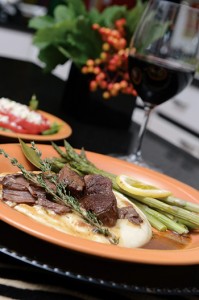
Winter Pot Roast With Asparagus
From Dr. Lou Schneider
Passion and comfort cavort year round in the kitchen of Dr. Lou and Pat Schneider. “Lou cooks every night,” Pat says, explaining that they collaborate on menus during the week. She will do the shopping and the cleanup, “but he will do the heavy lifting.”
The Schneiders like to say, “Cooking is chemistry.” With a scientific background (Lou earned a Ph.D. in biophysics before he went to medical school), it was only natural that her husband would love to cook, Pat says. “Besides being a great stress reliever after a day of caring for patients, cooking gets his mind to do something creative rather than scientific,” she explains.
“Comfort to Lou means having good friends, family and a busy kitchen,” Pat adds. Risotto, Bolognese sauce and pot roast are just some of his favorite comfort foods that he and his wife turn to as they forge a new gastronomic tradition of their own.
Lou likes to serve his Old World pot roast with asparagus in a paper bag. The roast, which endures because it can transform a relatively inexpensive cut of beef into a special world-class delight, is not necessarily one that brings back memories for Lou—he is more enthusiastic and skilled in the kitchen than his mother was, Pat says. But without question, this pot roast, one of Lou’s signature dishes, is so popular at winter gatherings that it is clearly an heirloom in the making.
Ingredients
5-pound beef chuck roast
2 tablespoons olive oil
1 1/2 cups chopped carrots
1 1/2 cups chopped onions
Bottle red wine (For the roast here,
Dr. Schneider used a Louis Martini cabernet.)
Beef stock to cover meat
1-1/2 cups chopped tomatoes
1 cup Italian parsley
6 stems fresh thyme
4 cloves garlic
2 tablespoons cornstarch
Salt, pepper, allspice to taste
Directions
Sear beef in 2 tablespoons olive oil in Dutch oven until brown on all sides.
Take meat out of Dutch oven and add carrots and onions. Cook until softened in olive oil.
Put meat back in with vegetables.
Add bottle of wine and beef stock to cover all. Add tomatoes, parsley, thyme and garlic. Add salt, pepper and allspice to taste.
Bring to boil on stove. Place foil over top of Dutch oven and cover with lid. Put in 450 degree oven for 15 minutes then reduce heat to 325 for 3 1/2 hours. Take meat from oven and strain juice into pan.
Mix 2 tablespoons cornstarch to 2 tablespoons red wine. Add to sauce until thickened. Serve over mashed potatoes, noodles or polenta.
Serves 6-8
Asparagus in Paper Bag
2 pounds asparagus
1 lemon thinly sliced
2 bay leaves
Sea salt and pepper
Olive oil
Clean and trim asparagus. Dry off. Place in paper bag with 1/2 lemon slices, bay leaf and salt and pepper.
Seal the bag and place on baking sheet. Coat bag with olive oil and bake at 350 degrees for 20 minutes.
Open carefully and add more olive oil to serve.
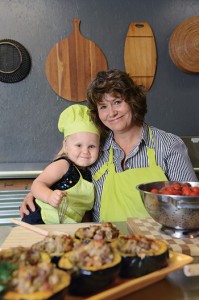
Burl’s Sausage Stuffing
From Mary Miller-Smith
The backbone of the dish—turkey and sausage stuffing—is so unassuming that Mary Miller-Smith was astounded by the number of recipe requests she received after she served it at an event. “I put some of my father’s sausage stuffing in acorn squash for a fundraiser at the Des Moines Community Playhouse, and after that I had more people calling me for the recipe,” she says. “It was kind of funny, but I think it was because the turkey and stuffing were so comforting.”
Miller-Smith is chef-owner of Park & Eat First-Class Catering in Des Moines. In a year, she will take on about 100 projects, mostly for corporate affairs or private at-home functions. As a child, back in the 1960s and ’70s, she worked in her family’s Park & Eat Diner in Iowa Falls. Opened by her father, Thomas “Burl” Jones, in 1945 after he returned home from World War II, Park & Eat flourished for more than 40 years as “one of those places in a small town that people depended on,” Miller-Smith recalls.
“We worked on Thanksgiving Day,” she says. “The sausage stuffing with scalloped turkey was something that my dad would make if we had a lot of turkey left over.”
Her dad, called “Burl” by almost everyone, believed strongly in attention to detail. “Those were the days when almost everyone ate a big breakfast, and my dad always made his own breakfast sausage,” Miller-Smith says. “Having handmade breakfast sausage in the stuffing made it so good. This is really the only stuffing I’ve ever known.”
 Ingredients
Ingredients
3 cups cooked brown or wild rice
4 tablespoons butter
2 tablespoons canola oil
2 pounds pork breakfast sausage
3 teaspoons ground or rubbed sage
1 teaspoon dried thyme
3 cups chopped sweet onion
3 cups sliced celery
12 cups cubed dried bread (approximately 24 slices)
1 teaspoon fresh chopped rosemary (optional)
1/4 cup chopped fresh parsley
2 teaspoons fresh ground pepper
8 cups homemade chicken stock or 8 cups canned low-sodium chicken broth
1-2 teaspoons kosher salt or to taste
Directions
Preheat oven to 350 degrees.
Cook brown or wild rice according to directions on package. You will need 3 cups of cooked rice.
In a large sauté pan or Dutch oven, melt butter and oil over medium heat. Add sausage, sage and thyme. Continue to cook, stirring occasionally to break up sausage. When sausage is cooked, add onion and celery, cooking until just soft. Remove from heat.
In a large bowl, mix cube dried bread, sausage mixture, cooked rice, rosemary, parsley, and pepper with 6 to 8 cups of chicken stock. Stir to mix well and taste for seasonings. Add salt to taste, if desired.
Spray a 9-by-13-inch casserole dish with nonstick cooking oil. Transfer the stuffing to the dish and bake for approximately 1 hour, stirring occasionally until golden brown on top.
This can be served with turkey, mashed potatoes and gravy.
Use any leftovers to make Miller-Smith’s scalloped turkey.
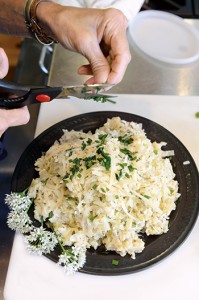
Grandma’s Risotto With Cabbage
From Lisa LaValle
With so many dishes in her repertoire, chef Lisa LaValle might have hesitated when asked to share a recipe that warms her heart as the days start getting colder. But the choice seemed easy to her. “Risotto with cabbage is my absolute favorite,” she says. In addition to being extremely tasty for a dish that is easy to make, this creation brings back memories of the way her grandmothers cooked and of her honeymoon in Italy with her chef husband, Michael LaValle of the Des Moines Embassy Club.
“We had our first authentic risotto on the Amalfi Coast. It was made with asparagus because that was in season,” Lisa LaValle recalls. The simple affability of her own risotto recipe and the fact it is made with cabbage, an ingredient she often encountered as youngster, connects her to so many dishes from her past. “You can stir this as much as you want while it is cooking,” she says. “I have found that it is a good activity for a house guest who wants to help cook. My grandmothers would have stirred it themselves the whole time, of course.”
LaValle’s recent move to the new restaurant at the Greater Des Moines Botanical Garden, after more than 20 years at the Des Moines Art Center Cafe, has allowed her to build a restaurant from the ground up. Expect to see plenty of seasonal ingredients from the plant world, she says. Risotto with cabbage could make an appearance someday at her new restaurant. But even if the recipe stays inside the family, the dish, with all its legend and lore, has already been embraced by a new generation, LaValle says: “All three of our daughters think making risotto is cool.”
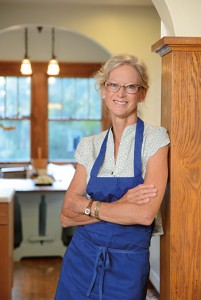 Ingredients
Ingredients
3 tablespoons olive oil
1 cup arborio rice
1 small diced onion
2 cups thinly sliced green cabbage
1-1/2 cups broth (chicken or vegetable)
Splash of white wine
1 teaspoon salt
3/4 cups white melting cheese
Small bunch of Italian parsley
Pepper to taste
Directions
Heat oil in a heavy saucepan over medium heat. Add rice, stirring
for about 5 minutes until rice is toasty and squeaks.
Add onion and cabbage. Cook and stir another 5 minutes or so until veggies are transparent.
Then add broth, wine and salt. Bring to a boil, then reduce heat to very low
and cook 45 minutes or so, stirring off and on.
Add cheese, parsley and pepper.
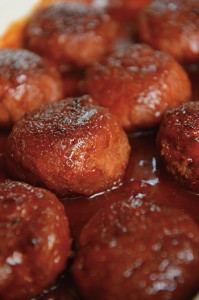
Grandma Doris Kline’s Ham Loaf Balls
From Abbe Hendricks
As a sommelier, Abbe Hendricks has deep appreciation for wines from far-flung corners of the world. But the situation is different when it comes to food, she says: “I am a traditional Midwestern girl. That’s why these ham balls fit the bill as a favorite seasonal comfort food.”
The ham balls were the most anticipated dish for Thanksgiving, Christmas and Easter in her family. “They weren’t necessarily my favorite until I grew older and learned to appreciate the balance of sweet, savory and acidic in the same dish,” Hendricks says. “The vinegar always threw me off, and I refused to eat (them) as a child. By the time I had figured out the world, at 15 years old, they were finally my favorite food during the holidays. I remember adding extra sauce to my plate, to mix into my mashed potatoes and soak up with my dinner roll.”
Handed down by her Grandma Doris Kline, this recipe has made its way to the third generation in Hendricks’ family. She and her sister get into boasting jousts about who prepares them better. Today, the recipe is featured in her family’s “very official” cookbook. Sometimes, just looking at the recipe can be “a soul-satisfying experience,” Hendricks says. ”It is certainly a simple Midwestern dish. But it makes everything in the world seem right for the few seconds it takes to devour them.”
 For the ham balls
For the ham balls
2 pounds of ham loaf mix (a blend of ground ham and ground pork)
1 cup graham cracker crumbs
3/4 cup milk
1 egg, beaten
Mix together and form into balls.
Place balls in glass dish, spacing without letting them touch.
For the sauce
1 can tomato soup
1 1/2 cups brown sugar
1/2 cup apple cider vinegar
1 tablespoon mustard
Mix together and pour over the balls.
Cover the baking dish with foil and bake 1 hour at 325 degrees. After 1 hour, remove the foil, baste balls with sauce in pan, and return to oven to bake for an additional 30-45 minutes, until there is a golden caramelized crust over the balls from the sauce.
The balls can be made ahead of time and frozen, and the sauce mixed and stored in the refrigerator.
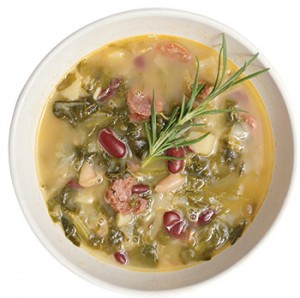
Portugese Kale Soup
From Tom Perry
Sopa de Couves, or kale soup, is a great conqueror of cold weather. Originating in Portugal, this soup migrated from the Iberian Peninsula with countless variations. Hence, no matter what anyone may say, there is no single correct way to make Portuguese kale soup. My mom, Leona Bourque, who is of French Canadian heritage, my grandmothers and my aunts on my dad’s Portuguese side of the family all had their own versions. They improvised at will.
The essential ingredients, at least in my extended family, were onions, garlic, potatoes, spicy Portuguese sausage known as linguica and, of course, kale, which some replaced with collard greens because that tasted more like the kale in the Old Country.
Perhaps the one topic that generated the most discussion was kale preparation. Debates, seldom in English, about whether the kale could be left roughly chopped or had to be finely shredded, as in Portugal, would pop up without warning. I’ve used both techniques; Sopa de Couves is accommodating either way. The same is true of beans. Some cooks include them. Some don’t. Finally, linguica, the Old World cousin of Mexican chorizo, is hard to find outside Portuguese-American communities. (Gateway Market sometimes carries the sausage.) The best substitute for Portuguese sausage is andouille, which is widely available in Central Iowa. Do not use Mexican chorizo as it is too soft and seasoned too differently.
I have included my favorite recipe below, which comes close to tasting like my mother’s. Both of us suggest that you keep in the spirit of our family’s style of cooking by thinking of the recipe more as a rough guide than instructions that must be followed.
Ingredients
1 bunch of kale or collard greens
1/2 head green cabbage
2 cans beans (options: red, white or even garbazno)
1-2 tablespoons olive oil
1 pound linguica or chourico (Portuguese sausage), or andouille or other smoked sausage, sliced 1/4-inch thick, or to preference.
1 medium onion, chopped
3-4 cloves garlic, minced
6-8 cups chicken stock, or 6-8 cups reduced-sodium chicken broth
1 pound potatoes, chopped. (Peeling is optional, depending on type of potato.)
1 14.5-ounce can diced tomatoes
1-2 teaspoons crushed red pepper flakes
3 bay leaves (preferably Turkish)
1/8 teaspoon of Hungarian paprika
Coarse salt, fresh ground pepper to taste
Directions
Wash kale under running water. Strip from tough stem, chop and set aside. Shred cabbage. If using beans, drain and rinse.
Heat the olive oil over medium heat in a large stock pot. Add sausage, onion and garlic. Cook, stirring occasionally until the onion is transparent.
Add remaining ingredients. Bring to a boil. Reduce heat and simmer for 45 minutes to 1 hour. Adjust liquid as needed for desired consistency. Add salt and pepper to taste, remove bay leaves and serve hot with cornbread or coarse bread.
This recipe will serve six to eight people easily. It reheats very well the next day and will keep in an airtight container for three days.





